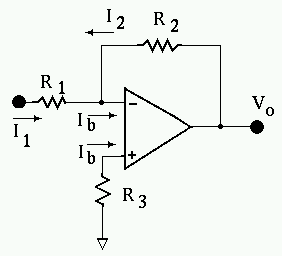
Figure 1
 Figure 1 |
Ib = 1 uATrue since
R1 = 10K
R2 = 25K
R3 = 0The component of Vo due to Ib is
Vo = R2*Ib = 1 uA * 25K = 25 mV
V+ = -R3*IbI1 + I2 = Ib
(Vin + R3*Ib)/R1 + (Vo + R3Ib)/R2 = Ib
Multiply by R2
V0 + R3Ib +(R2/R1)[Vin + R3Ib] = R2Ib
Solve for Vo
Vo = -(R2/R1)Vin + Ib[R2 - R3 -R2R3/R1]
The effect of Ib on Vo will be zero if R2 = R3[1 + R2/R1] = R3[(R1+R2)/R1]
R3 = R1R2/(R1+R2)
This is the well known method for reducing the effect of Ib. That is, set the impedances seen by the non-inverting input equal to the impedance seen by the inverting input.
But if R3 = zero, as in this problem,
Vo = -(R2/R1)Vin + IbR2
Also, with R3 = 0, V- = V+ = 0, and therefore I1 = 0
so I2 = Ib